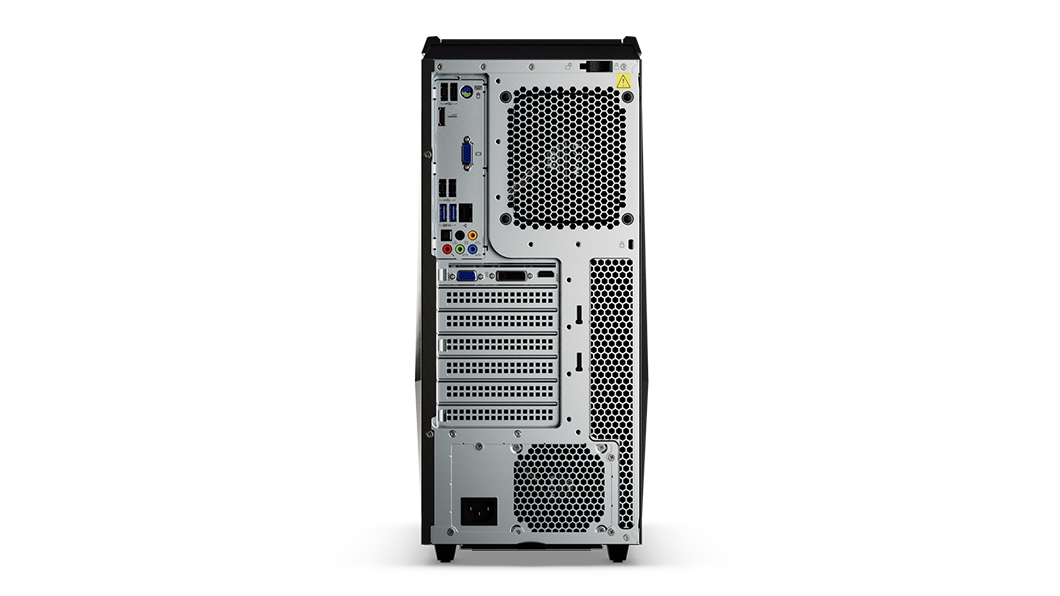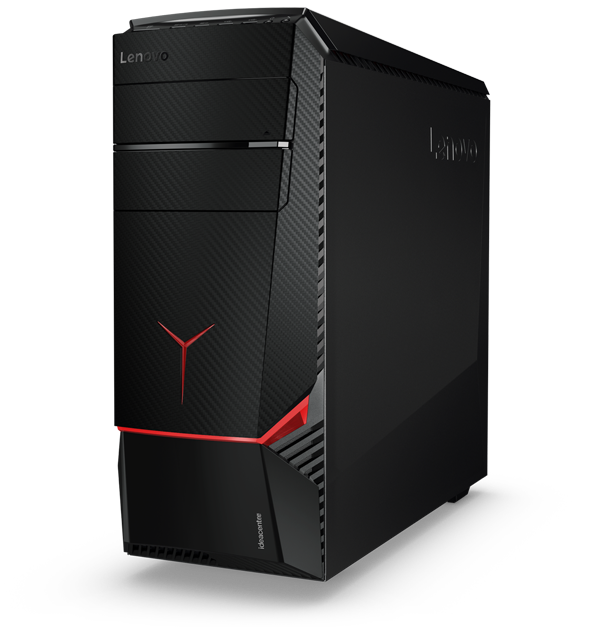Tom's Guide Verdict
The Lenovo Ideacentre Y700 performs well for an entry-level gaming PC, but it's not quite as sleek or feature-rich as the competition.
Pros
- +
Easy to upgrade
- +
Fairly affordable
- +
Strong gaming performance
Cons
- -
Competitors offer more style and features
- -
A bit bulky
Why you can trust Tom's Guide
Enjoying PC gaming is less terrifying to your wallet than ever, largely thanks to machines such as the Lenovo Ideacentre Y700 that cram powerful parts into an affordable package. The Y700's Core i5 processor and GTX 1070 graphics card make it well equipped for playing modern games at high settings and handling virtual reality. In addition, its easy-to-upgrade chassis makes adding new components a breeze. The Y700 is a solid entry point for new PC gamers, though you can find more stylish and customizable options in the same price range.
Design
The Lenovo Ideacentre Y700 is nearly identical in design to its more premium Y900 counterpart, meaning you'll get the same black, scaly chassis and huge glowing Y logo on the front. You won't, however, get the Y900's transparent side panel, though you can still see the green glow of the PC's graphics cards through a small vent on the side.

You can adjust the dimness of the Y700's front-facing lights (or turn them off) via a built-in app, but you're stuck with red for the color. If that's a deal-breaker for you, Lenovo's upcoming Razer Edition PCs will let you go wild with a whole bunch of different hues.
The Y700 takes up a decent amount of space at 20 x 19 x 8 inches and weighs a hefty 33 pounds, but a handle at the top makes it fairly easy to carry. The PC is slightly bigger than Alienware's Aurora mid-tower, but a bit smaller than Acer's monstrous Predator G6.
MORE: The Best Gaming Desktops Available Now
Ports and Upgradability
The Y700's front panel makes it easy to plug and play, with two USB 2.0 ports, two USB 3.0 ports, a 7-in-1 card reader and headphone and mic jacks. There's also a DVD-R drive for those still clinging to physical media.

You'll find everything else you need in the back, including four more USB 3.0 ports, an additional two USB 2.0 ports, an Ethernet jack, a full suite of audio ports and a PS/2 connector for ancient mice and keyboards. The Y700's Nvidia GTX 1070 graphics card packs three DisplayPorts, an HDMI port and a VGA ports, giving you plenty of options for connecting to multiple monitors.
Get instant access to breaking news, the hottest reviews, great deals and helpful tips.
Opening up the Y700 is a breeze -- once you pop a lock on the back panel and press a button at the top, the PC's side panel comes right off. From there, you'll have easy access to just about every component, including RAM slots and hot-swap storage bays.
You can even remove the graphics card tool-free, though you will have to fiddle with a few plugs and switches before you get there. I still prefer the more seamless tool-free lever on the Alienware Aurora, but I appreciate that I can take out the Y700's GPU without busting out a screwdriver.
Gaming Performance
The Y700 has Nvidia's new GeForce GTX 1070 GPU, which is designed to handle VR and graphic-intensive games without the higher price tag of the beefier GTX 1080.
Lenovo's PC proved capable of handling the gorgeous Rise of the Tomb Raider in 4K with graphics set to high, rendering the game's snowy mountains and lifelike hair physics at a steady 40 frames per second. Lowering the resolution to 2560 x 1440 yielded an even smoother 60 fps.
The Y700 yielded an impressive 97 fps on our Grand Theft Auto V test, which consists of a scripted sequence of open-world mayhem with graphics maxed out at 1080p.
The performance perks of Nvidia's new 10-series GPUs became clear once we ran the Y700 through the 3DMark Fire Strike Ultra test, which measures 4K performance. Lenovo's PC scored a 3,123, topping the Alienware X51 (2,446) and the Asus ROG G20CB (2,153), both of which use the older GTX 970 cards.
MORE: The Best Gaming Laptops
VR Readiness
The Y700's Nvidia GTX 1070 graphics card makes it VR-ready on paper, but we ran a few tests just to be certain. Lenovo's PC got the thumbs up from Oculus' Compatibility Check app, which scans your system to ensure you have the proper CPU, GPU and ports for virtual reality.
Lenovo's PC performed admirably on the SteamVR Performance test, which runs your system through a Portal-themed demo to measure its virtual-reality chops. The Y700 scored a 10.9, which Valve calls more than enough for high-end VR. That's just barely behind our GTX 1080-powered Lenovo Y900 and the Alienware Aurora, both of which scored 11.
Overall Performance
With a 6th-gen Intel Core i5-6600 processor and 8GB of RAM, the Y700 is perfectly good at juggling multiple tasks in between game sessions. I never experienced any significant slowdown while using Lenovo's gaming machine, even as I bounced between Google Docs, email and four different Twitch streams while running a full system scan and copying a folder full of games in the background.

Lenovo's PC scored a 10,788 on the Geekbench 3 overall performance test, performing comparably to the Asus G20CB (10,979, Core i5) but lagging behind a Core i5-powered Alienware X51 (12,526) and the 14,743 gaming desktop average.
The Y700's 128GB SSD copied about 5GB of files in 46 seconds, for a rate of 110.6 MBps. That's slower than the 256GB SSDs found in our Asus G20CB (171.3 MBps) and Alienware X51 (279.3 MBps).
MORE: Here Are the Best PC Game Controllers
Software
The Y700 comes with a non-intrusive batch of Lenovo apps, but you probably won't use most of them. Aside from the aforementioned LED Control Center, there's Lenovo Companion, a central hub that lets you monitor your system's health, view warranty information and browse guides and tips.
There's also Lenovo's ShareIt app, which lets you beam files between your smartphone and PC, as well as ReachIt, a cloud-storage app that, coincidentally, was recently discontinued. You can burn DVDs with the Power2Go app, or view media files with PowerDVD.
Keyboard and Mouse
Lenovo is likely banking on you bringing your own gaming mouse and keyboard to the party, because the Y700's peripherals are extremely vanilla. Lenovo's USB mouse and keyboard work just fine for everyday computing, but they lack any gaming-centric features.
Lenovo's keyboard is fairly snappy, but its keys start to feel a bit shallow once you start hammering away. I was able to type at a speedy 104 words per minute with near-perfect accuracy on an online typing test, though my hands got a bit cramped whenever I typed that fast.
The included mouse is perfectly comfortable, but don't expect the thumb buttons and DPI switch that come standard on any gaming mouse.
MORE: Our Favorite Gaming Mice for Every Genre
Configurations
We reviewed the lone $1,349 version of the Y700, which packs a 6th-gen Intel Core i5-6600 processor, 8GB of RAM, a 1TB, 7,200-rpm hard drive with a 128GB SSD and an Nvidia GeForce GTX 1070 graphics card. You'll also get Lenovo's stock USB mouse and keyboard.
Bottom Line
The $1,349 Ideacentre Y700 accomplishes its goal of providing VR-ready gaming performance at a decent price. Its Nvidia GTX 1070 graphics card and Core i5 processor are ideal for both graphically rich gaming and productive multitasking, and its easy-open chassis means that even tech newbies can add new parts over time.
However, the Y700 isn't the only entry-level gaming PC out there, nor is it the cheapest. The Alienware Aurora with similar specs will run you a slightly cheaper $1,224 and has a sleeker, more customizable chassis, while the Asus ROG G20CB ($1,449 as reviewed) packs similar guts into a wonderfully compact body. You won't be disappointed by the Y700's overall performance, but it's got some seriously worthwhile competition.
Mike Andronico is Senior Writer at CNNUnderscored. He was formerly Managing Editor at Tom's Guide, where he wrote extensively on gaming, as well as running the show on the news front. When not at work, you can usually catch him playing Street Fighter, devouring Twitch streams and trying to convince people that Hawkeye is the best Avenger.


